09.04.25
Real Talk, Real Growth: The Case for Honest Feedback
HR Headliner

Real Talk, Real Growth: The Case for Honest Feedback
September 2025
At Sierra HR, we often hear from managers who are frustrated with an employee’s unreliable attendance, or subpar performance, or lack of initiative and motivation. “What should we do?” the manager asks. Our typical follow-up: “What have you done so far? Have you talked with this employee about the problem? What was their response?” And that’s where things tend to go downhill.
For a wide variety of reasons, managers are often apprehensive about taking corrective action. Some managers think that having a “negative” conversation will put a damper on the employee’s morale (“We really don’t want to bum her out.”) Or maybe the employee is dealing with personal problems, and the manager doesn’t want to seem uncaring (“I heard he’s going through a lot at home…”) If feedback is given to an employee at all, it’s often a watered-down or sugar-coated version of the intended message.
But unclear feedback isn’t kind or compassionate. It’s confusing, and can actually prevent the employee from being successful in the job and growing with the company. Sugar-coated feedback allows the employee to continue down a path toward frustration (on both sides), a lack of job satisfaction, and possible termination. As managers, it’s our job to be both kind and clear. We should give direct, actionable information in a way that shows support and preserves the relationship. Consider these examples the next time you’re hesitant to have a tough conversation:
Instead of: “You’re doing great, just a few little things to tweak.”
Say this: “You’ve made strong progress. Let’s look at your job description and talk about two specific areas that still need work.”
_ _ _ _ _
Instead of: “Maybe try to be a bit more proactive?”
Say this: “Moving forward, I need you to take initiative in [specific area], especially when it relates to [cite applicable company values or priorities].
_ _ _ _ _
Instead of: “Just something to keep in mind for next time…”
Say this: “This is a key area of development for your role. Let’s agree on a plan to improve it.”
_ _ _ _ _
Instead of: “Sorry, I just wanted to mention real quick…”
Say this: “I want to bring this to your attention because it’s important for your growth and success in this job.”
Feedback that is clear, direct, and growth-focused shows respect for your employee and gives him/her the best shot at success. It also supports the company’s mission, values, and goals. Good managers can offer compassion and support while also standing firm on the performance expectations of the position. This balance is what leadership is all about.
07.02.25
Form I-9 Reviews
HR NEWS
Form I-9 Reviews
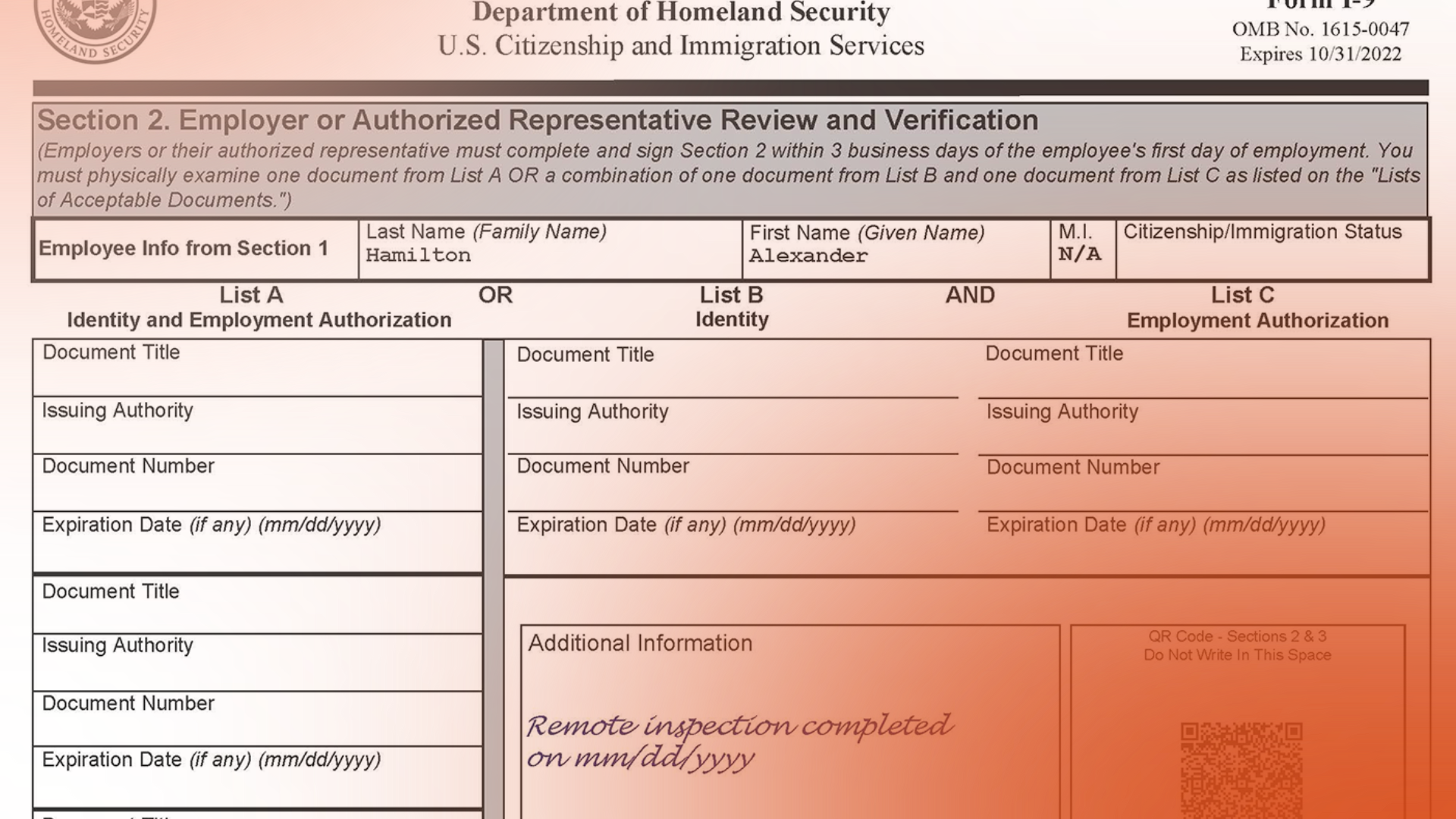
On Tuesday, June 10, the U.S. Immigration and Customs Enforcement agency (ICE) conducted the largest worksite enforcement operation in Nebraska so far this year, detaining 76 people from Glenn Valley Foods in Omaha. In a press release about the operation, ICE suggested more such operations, stating that:
“Worksite enforcement remains a priority for ICE as it seeks to protect the nation’s workforce, eradicate labor trafficking and hold employers accountable for practices that encourage illegal immigration. Employers found in violation of federal hiring laws may face civil penalties and, in some cases, criminal prosecution.”
In southern California, protests that turned into riots over immigration enforcement have led to clashes between local police and federal agents. President Trump’s deployment of the California National Guard was initially blocked by a federal judge, but that order was temporarily overruled by the 9th Circuit Court of Appeals.
State tensions and stories of imminent worksite enforcement operations – Glenn Valley Foods had never seen such an operation before – have left many employers skittish and eager to ensure their compliance with federal I-9 requirements. Yet employers should be careful; mishandling I-9 audits or corrections can lead to legal risk.
Remember these tips:
– I-9 Form expiration dates don’t “expire” a completed form. The “expiration date” at the top of an I-9 form applies to when the form should be replaced with a more current version. It does not signal a requirement for employers complete a new I-9 form for current employees.
– “List B” documents that verify an employee’s identity never need to be reverified. As long as a List B document was unexpired at the time of hire, it does not ever need to be reverified.
– Making corrections is not always simple, and unconfident employers should not do it alone. Sometimes I-9 corrections are as simple as adding in missing information. Often, making corrections is not a simple matter. The I-9 Handbook for Employers can be a helpful resource, as can Sierra HR or your attorney.
You don’t need to audit or correct I-9 forms on your own! Sierra HR Partners can assist you in making compliant corrections where needed, while minimizing legal risk with employees who have already verified their identity and employment eligibility. We can also train your administrative employees on how to complete and audit forms as employees are hired. Join us from 9 am – 10 am on July 10th for a detailed training workshop on the steps for completing Form I-9, inspecting employees’ documents, and properly re-verifying information. Click here to register.
06.09.25
HR Headliner June 2025: Don’t Let ChatGPT Drive You Off a Cliff
HR Bulletin

Don’t Let ChatGPT Drive You Off a Cliff
AI is a great tool… trust but verify!
In May 2018, an Oregon truck driver was missing for four days and had to walk 36 miles through the snow when his truck got stuck after his GPS mapping device sent him up the wrong road. In July 2024, a Utah man was stranded on a mountain for three hours after following a Google-suggested shortcut. And in January 2025, a Colorado man’s car got stuck at the bottom of a ski trail after following Siri’s driving instructions “to a tee.”
What do these unfortunate adventures have to do with our work in HR? They’re examples of how trusting the internet, and especially AI tools like ChatGPT, without using critical thinking skills can steer us far off track!
It’s becoming more and more common to use AI for a wide variety of HR tasks. We can write policies and job descriptions, generate training agendas, research compliance questions… the list goes on. These tools can be extremely helpful, but they shouldn’t be copied and pasted into formal company documents or used to make a complex employment decision without double checking the message. California employment law questions should get special review, because we know our state’s requirements are often different from federal law. The “AI Overview” at the top of your Google search often blends multiple online sources or adds a dash of federal law, creating confusion and potentially pointing you in the wrong direction. For example, a search for information about paying overtime to seasonal employees for a recreational program seems to indicate that short-term operations could be exempt. This is a federal rule, but there is no such exemption in California.
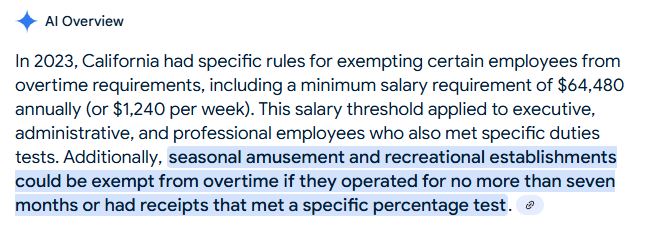
We asked ChatGPT if exempt employees are entitled to paid holidays, and the response seems clear at first, but could actually lead to confusion. Based on the table below, if the company does not offer paid holiday benefits, does the exempt employee receive pay for a holiday…or not? Further, this states that leave banks such as vacation can only be deducted in full-day increments, which is inaccurate.
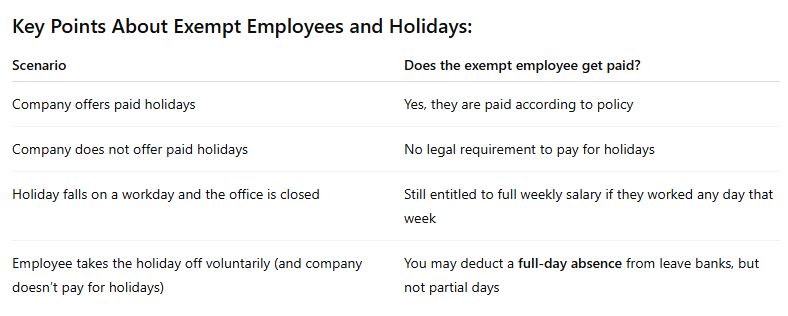
Next, we asked ChatGPT if an employer could require a doctor’s note as a condition of approving paid sick leave. The AI recognized California’s protections regarding the use of state-mandated PSL, but uses a 3-day time threshold, which is not part of our current law. Employees are entitled to use up to five days or 40 hours of PSL per year, and we cannot require medical certification as a condition of using any available sick time.
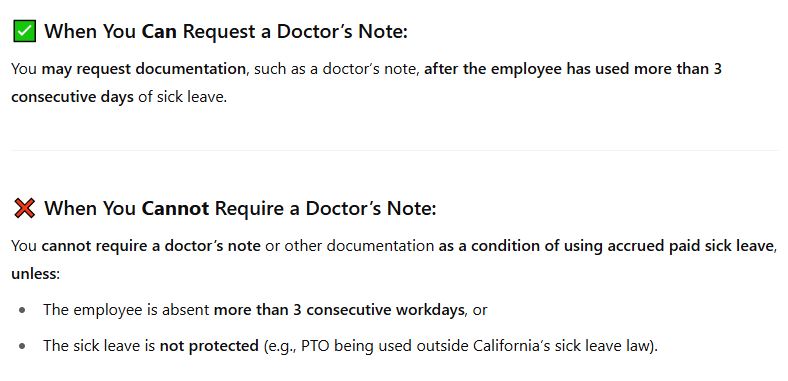
In some cases, the AI information may simply be outdated, as shown by this response to a search about paycheck deductions. Effective January 1, 2025, California’s minimum wage is $16.50 per hour, but the AI Overview still cites $16.00.

A 2023 HR Morning article describes the risks well: “While the AI could handle linear, straightforward questions, its answers became unreliable as questions got more complex. In almost all cases, the answers ChatGPT provided were missing necessary nuanced details and in some cases ChatGPT completely fabricated reference material that did not exist at all.”
We’re not suggesting that HR professionals avoid using AI tools! There can be many helpful benefits of this growing technology. But it’s important to remember that ChatGPT is not a replacement for your own critical thinking. As this Harvard Business Impact article describes, a rushed project or decision (especially one using flawed online guidance) rarely leads to the best result. Slow down, look for possible errors or confusion, and consider whether the information really applies to your business.
And, remember that the Consultants at Sierra HR are available to really listen to the nuances and details of your HR issues and provide legally-compliant resources and individual guidance. We promise to never leave you stranded!
04.03.25
HR Headliner: What Have You Done For Me Lately? Communicating Your Total Rewards Program to Employees
HR Headliner
April 2025 HR Headliner:
What Have You Done For Me Lately?
Communicating Your Total Rewards Program to Employees
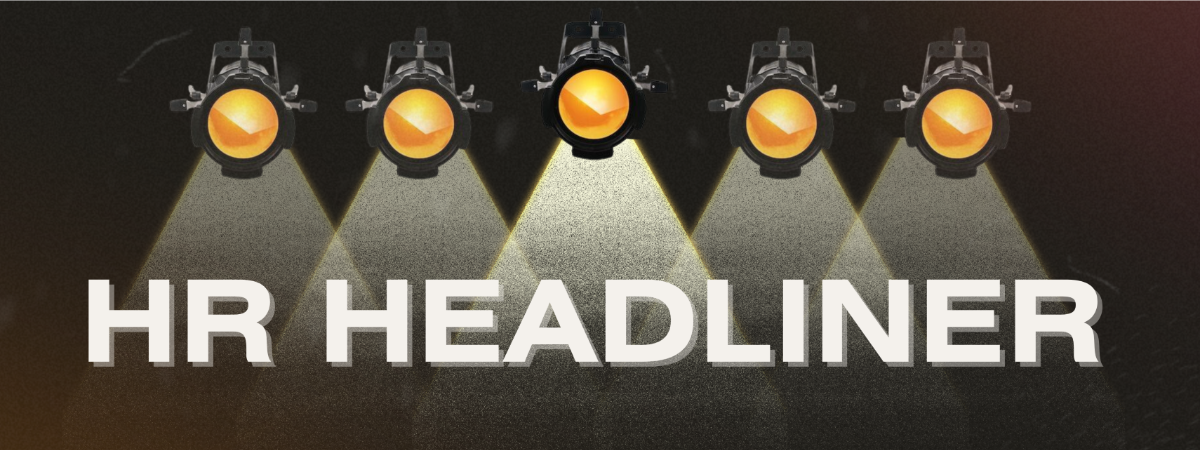
Business owners know that a competitive compensation package is essential for attracting and retaining great employees. Your “total rewards” program includes monetary factors such as wages, bonuses, paid time off, and insurance coverage, and non-monetary benefits such as employee recognition programs, flexible scheduling options, and career training and enrichment opportunities. With so much time and energy dedicated to developing these areas, do you ever feel that employees don’t fully appreciate what the company has to offer? Below are a few tips for effectively communicating your total rewards philosophy:
Start by being a good listener. Seek employees’ feedback about what kinds of compensation and benefits are most meaningful to them. Not only will this allow you to focus your budget on the best programs, it will help employees feel “in on things” and that their opinions matter to the company.
Connect your compensation package to the company’s mission and goals. For example, a company in a growth phase might emphasize client acquisition bonuses or job upskilling activities. A firm that values its community roots could highlight employee volunteering or sponsorship opportunities.
Provide clear, detailed information about each component of your total rewards program. Of course employees see the paychecks they receive, but do they understand all that their health insurance plan has to offer? Do they know about available training courses that may make them eligible for promotion? Do they know about an Employee Assistance Program that offers mental health support and financial planning assistance?
Use multiple communication channels. A beautifully-designed company newsletter may not be effective for employees who don’t sit at a desk or have time to check company emails during the day. Posted notices or printed memos delivered by supervisors can help to ensure everyone receives the right information. Be mindful of language differences, as well.
Address employees’ questions and concerns in a timely manner. If an employee is frustrated with your health insurance carrier or believes that new hires with less experience are receiving higher wages, it’s best to offer support and clarity before minor issues grow into larger grievances.
Provide comparisons and benchmarking information when needed. Employees may have inaccurate perceptions of what other companies provide. When appropriate, sharing salary surveys and other research can help to show that your business is staying competitive.
Sierra HR Partners is here to help you analyze your total rewards programs and communicate effectively with employees. Contact one of our certified Consultants with any questions you have!
03.10.25
HR Headliner: Is AI Influencing Your Interviews?
HR Headliner
March 2025 HR Headliner: Is AI Influencing Your Interviews?

HR managers and recruiters have long known that candidates may embellish their resumes to boost job-related experience. Back in my day, the trickiest move may have been to coordinate with a friend to give a positive professional reference, instead of allowing a recruiter to contact a real former supervisor. But the “new normal” of video interviews and AI tools like ChatGPT has opened up a whole new world of potential cheating.
In July 2024, reports were published about an international company that hired a North Korean cyber criminal after he used fake a employment history and AI-enhanced photo and video during the hiring process. Despite a seemingly thorough screening process that included video interviews and a background check, the hacker was able to gain employment, download sensitive company materials, and transfer potentially harmful files into the company’s systems.
While this may be an extreme example, the use of AI during the hiring process is becoming an increasing trend. ChatGPT can easily generate a well-written resume and cover letter, misrepresenting a candidate’s writing skills. Our recruiting team at Sierra HR has yet to experience an AI-faked video, but they have detected candidates using “teleprompter apps” that can listen to an interview conversation and feed real-time answers to the job seeker.
So, how can an HR manager or recruiter spot the fakes and hire the right (real) person? Below are a few guidelines for interviewing in this AI age:
- Plan in-person interviews with finalist candidates. Telephone and video meetings are efficient for initial screening, but there’s nothing like the real thing when it comes to having confidence in the person you’re hiring.
- Ask behavior-based questions during all phases of the interview process. AI may be great for generating answers to technical skills questions, but the candidate will have to rely on his/her own memory and discernment to answer a prompt such as, “Tell me about a time when you went out of your way to help a client, and how you might apply that effort to this position?”
- During video interviews, watch for signs that the candidate is typing while being asked a question, has unnatural pauses before responding, or his/her eyes appear to be tracking text or looking elsewhere. These could be signs that the person is entering your questions into an app and reading auto-generated responses.
- Ask follow-up questions if the candidate delivers a seemingly-confident response that does not clearly address the question being asked. This could be another signal that he/she is using AI to craft answers. Ask the person to dig deeper and provide more specific details, allowing you to gain better insight into potential job performance… or confirm your suspicion that the candidate isn’t really as good as he/she appears to be.
Whether you love the new tech developments emerging in our workplaces, or you’re concerned about potential negative impacts, AI is here to stay and will only become more efficient and convincing over time. Understanding and navigating the balance between AI tools and “irl” human interaction will continue to be a critical management skill.
If you’d like our input on a great (or questionable) candidate, or you’re hoping to outsource the entire recruiting process, Sierra HR Partners is here to help you hire the best people for your business. Contact one of our HR Consultants (consulting@sierrahr.com) or our Recruiting team (recruiting@sierrahr.com) with any questions you have.







